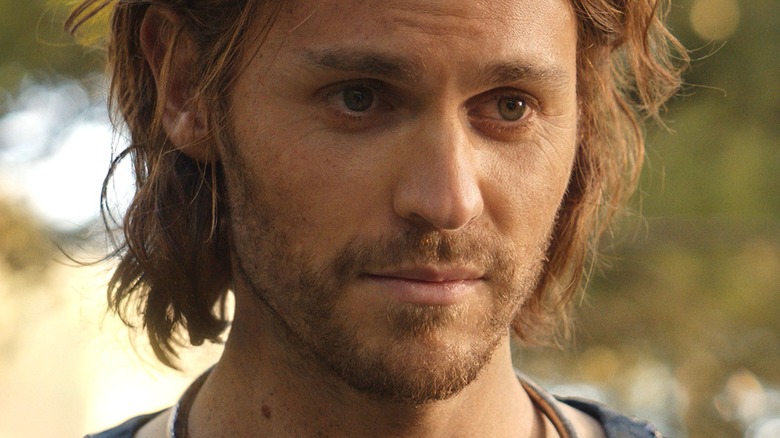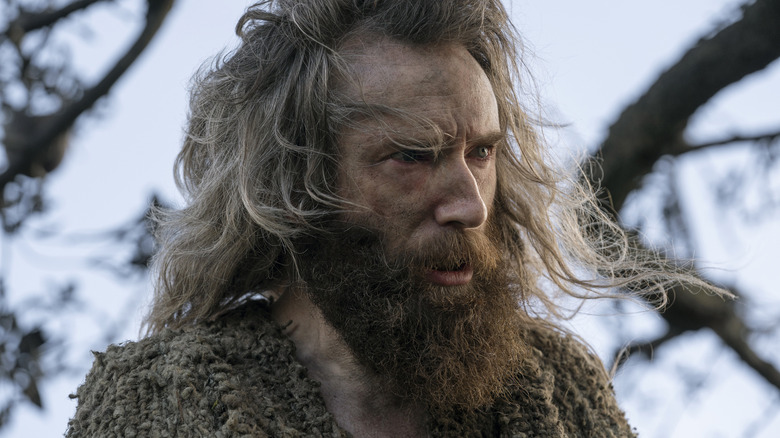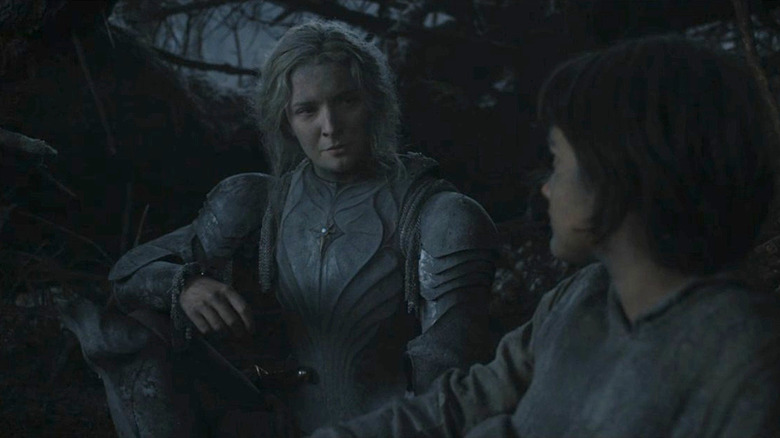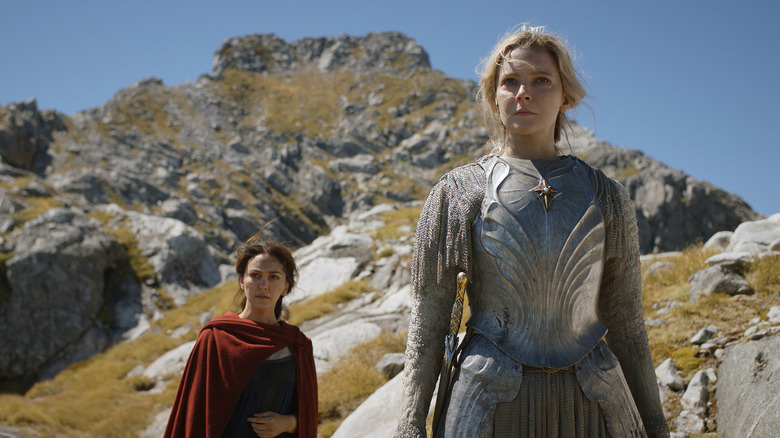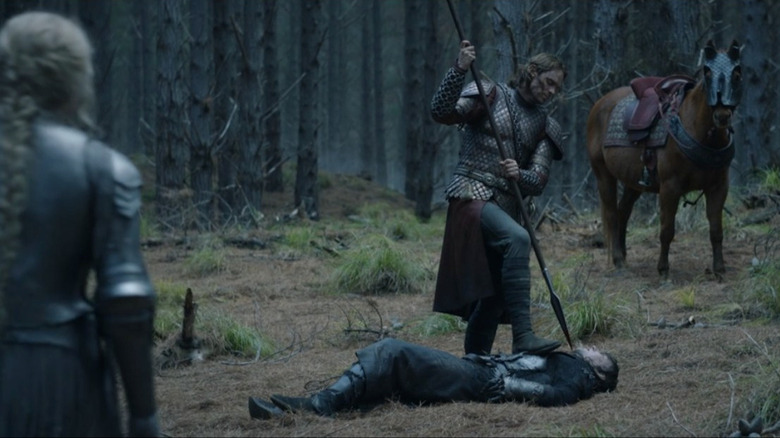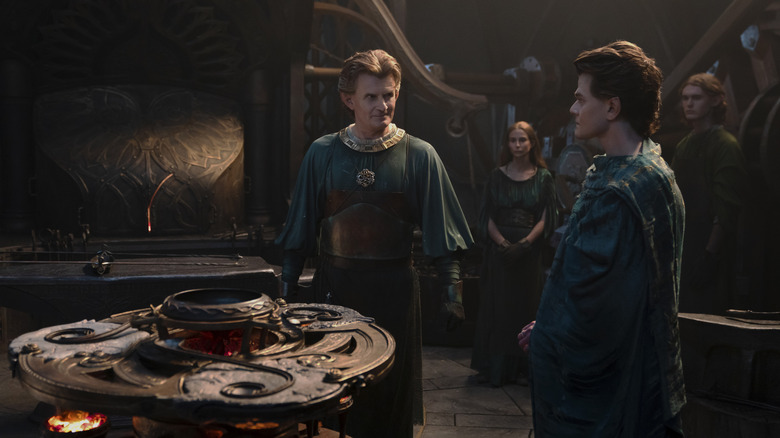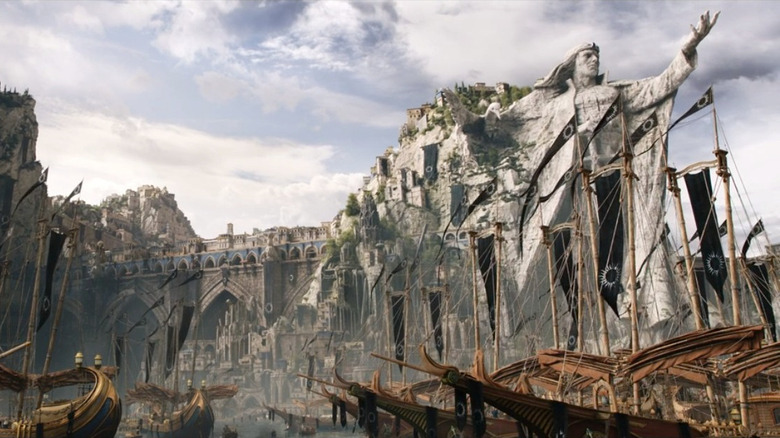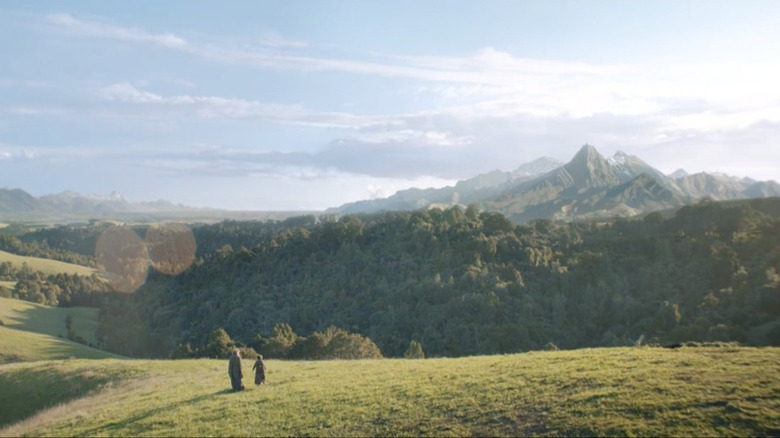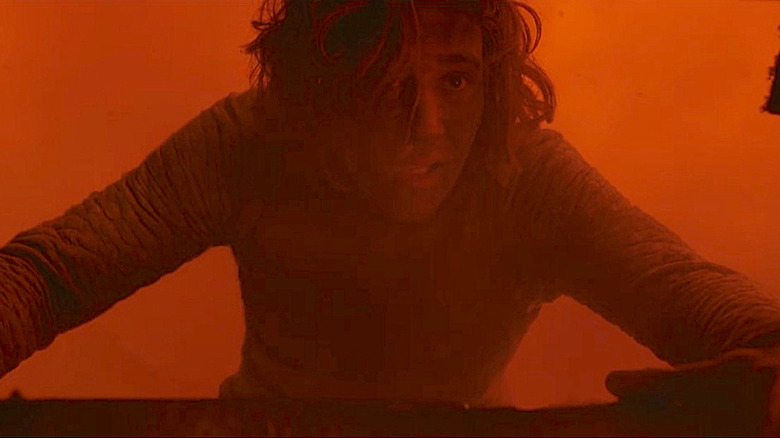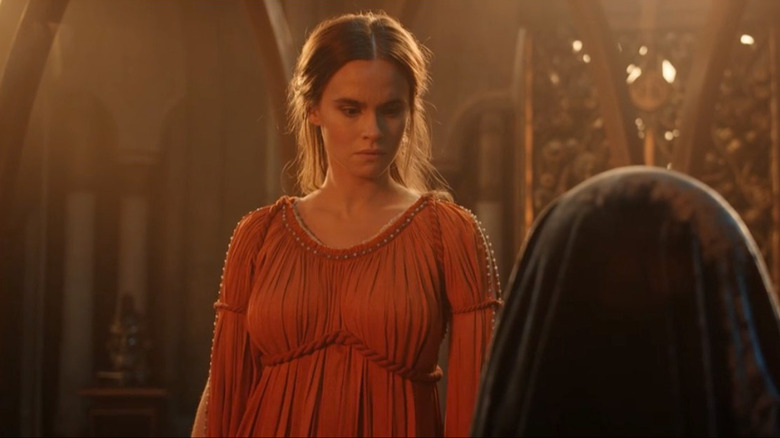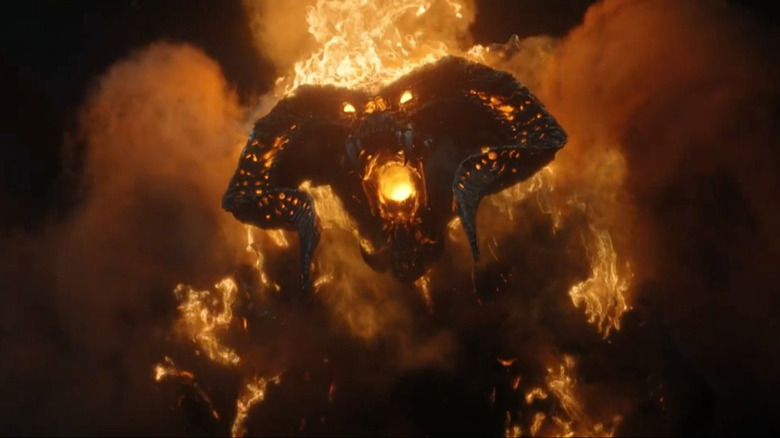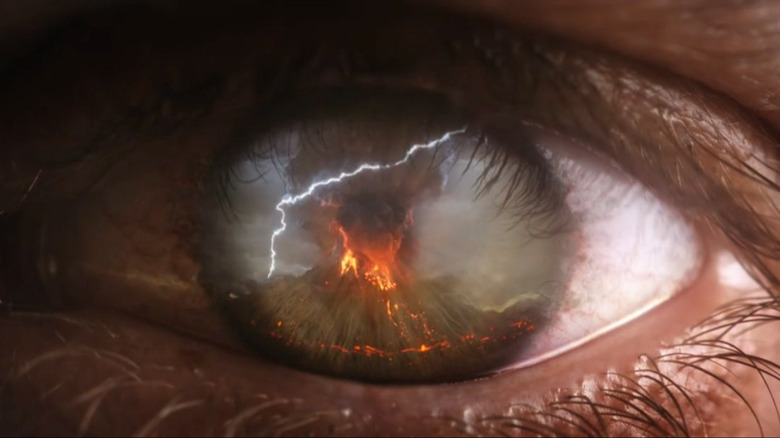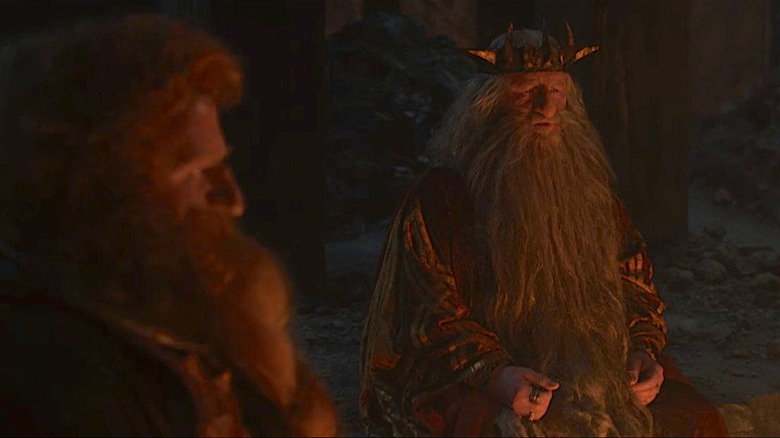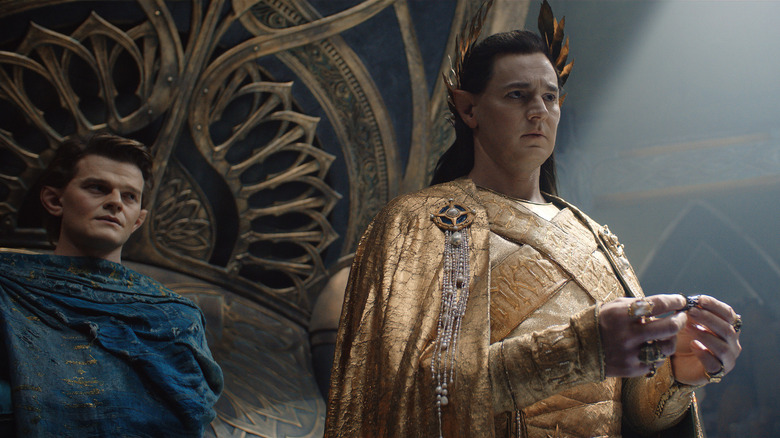Biggest Unanswered Questions In The Lord Of The Rings: The Rings Of Power Season 1
Season 1 of "The Lord of the Rings: The Rings of Power" has come and gone, and it's left a plethora of puzzling questions in its wake. It isn't surprising. The inaugural eight-hour installment of the five-season story tried to balance a massive narrative that involved twenty-two main characters and over half a dozen primary locations. This created so many story threads that it's a miracle showrunners J.D. Payne and Patrick McKay and their intrepid writing crew were able to address as many of them as they did by the time the season finale credits rolled.
Still, there are dozens of questions that remain unanswered, including some particularly juicy mysteries that are going to make it difficult to wait patiently for Season 2 — which thankfully has already started production. That said, we've pulled together several of the biggest unanswered questions from Season 1, along with some speculation on how each one could be resolved or impact the story moving forward. Here they are, in no particular order. Enjoy!
Spoilers for "The Lord of the Rings: The Rings of Power" Season 1 ahead!
Who on Middle-earth is the Stranger?
Let's say it all together now. Who is the Stranger? It's a question that has been haunting viewers ever since the meteor man came crashing down at the end of Episode 1. Since then, we've watched the wayward traveler slowly learn how to speak again. He's also discovered the difference between good and evil while helping the Harfoots along their migration.
The finale promised some bigger revelations, with fans hoping one of them would be learning who the Stranger might be. When the episode aired, though, all it revealed was that he is an Istar, one of the upper-case "W" Wizards of Tolkien's world, which is something everyone and their mother was aware of from the get-go. Sure, it was clarified that he wasn't Sauron, but apart from that information, we were left with little to nothing regarding his specific name.
Who on Middle-earth is this guy? Is he Gandalf? He does Gandalf-y things like talking to flying insects and telling Hobbits to follow their nose. Then again, he could be one of the mysterious, underdeveloped Blue Wizards. They travel east to areas like Rhûn (where the Stranger is headed at the end of the season) and are the only Wizards to actually operate during the Second Age in Tolkien's original writings. Is he someone else entirely? Radagast the Brown or an original character made up for the show? It's a baffling mystery with no sign of a resolution coming any time soon.
Where is Celeborn?
Celeborn is Galadriel's husband. He helps her rule Lothlorien in the Third Age and is around when Frodo and company stop in on their way to Mordor in "The Fellowship of the Ring." He has a vague but certainly substantial backstory in Tolkien's writings, too, and is generally in the picture alongside (or at least near) Galadriel for most of their long history together.
Yet, in Season 1 of "The Rings of Power," Celeborn is nowhere to be found. Literally. The future Lord of Lorien is reduced to a footnote when, in Episode 7, Galadriel causally mentions to Theo that she was married once, but her husband, Celeborn, went off to war and never came back.
It's an on-screen narrative twist that no one saw coming — and by the end of the season, no one has any idea where it was going, either. After his single mention, Celeborn remains firmly out of sight and out of mind, a head-scratching asterisk of a character that we all know has to be resolved sooner or later. The question is, how will the show tie this aberration from Celeborn's original story back into the larger Second Age theme? Where has he been? Why hasn't he shown up over all of these years? Is he trapped somewhere? Does he have amnesia? Does he become evil and require redemption? Can we use a lifeline? We need more information here!
What will happen to the Southlanders?
The last time we see the Southlanders is in Episode 7. The rag-tag group has just gathered on the other side of the mountains of Mordor after escaping from the volcanic destruction of their homeland. After the survivors unite and bandage their wounds, Bronwyn informs everyone that they're heading down to an old Númenórean colony called Pelargir. Once they get there, they'll start a fresh life, hitting the reset button and putting their catastrophic past behind them.
It's a nice sentiment, and it sounds hopeful. Still, what will it actually look like when it plays out next season? The way Bronwyn talks about the place, it seems like it could be a little out-of-the-way settlement or even an abandoned area. In the source material, though, it's a powerful city and a continent-based bastion of the Faithful — that is, the minority political faction on Númenor that still remains friendly with the Elves. Will the Southlanders find this pro-Elvish city already up and running in J.D. Payne and Patrick McKay's adaptation? Or will they be starting life all over again on their own?
Once that question is answered, others quickly arise, as well. Will they become Númenórean allies? Will the death of King Tar-Palantir mean the Númenóreans will become bullies and the Southlanders will have overlords again? There's a lot of potential — both for good or ill — ahead for this scrappy group of survivors.
What happens when Adar and Sauron meet again?
Sauron and Adar are two of the primary villains of Season 1. They also have quite the backstory. Season 1 exposition informs us that as Morgoth's second in command, Sauron remained highly influential after his master's overthrow. Adar followed Sauron into the north and lost many of his beloved Orcish children to Sauron's devilish experiments, only for Adar to split the new Dark Lord open (his words, not ours) and lead his followers off on a journey across the entire length of Middle-earth. At the end of that epic trek, they unleash Mount Doom and set up shop in their cozy, cloud-covered new home.
Of course, unbeknownst to them, Sauron is already there in his hunky new form as Halbrand, the returned king of the Southlands. In fact, at one point, Halbrand even threatens Adar and nearly kills him, asking him if he remembers who he is. Fast forward a bit, and the last scene in Season 1 shows Sauron arriving back in Mordor, where a conflict between the two leaders inevitably awaits.
What will that look like, though? Will the two have a classic duel, like Sauron and Isildur eventually do? Will Sauron backstab Adar before he even knows it? Will the Dark Lord, who loves order and obedience, try to cow his warped Elven inferior into following him again? It's a situation that will likely take center stage when things pick back up in the next season.
When will we get the other Rings of Power?
This next question has at least partially been answered by the showrunners in a post-finale interview (via Vulture). In response to the question about why they didn't use Sauron's title as "Annatar, Lord of Gifts," Patrick McKay talked about Halbrand/Sauron's "gift" to Celebrimbor, which helps him forge the Three Elven Rings. He adds that "at the end of Season 1, three rings have been crafted, and as you know from the song Fiona Apple sings at the end of the season, there are still seven for the dwarves, nine for the men, and one for the Dark Lord to come. There are more gifts yet to come."
So, at least we know that the creators are still aware of the other Rings of Power, and they have a plan to introduce them into the story. The question is, where and when will that happen? In the source material, the Nine and Seven Rings are made first. They're forged by Sauron (disguised as Annatar) and Celebrimbor together. Only after that point does Celebrimbor make the Three, and then Sauron goes off and forges the One Ring to rule them all.
In the series' rewrite of the timeline, we already have the Three Rings for the Elven-kings first, with the others apparently set to follow as "gifts" later on. Will Celebrimbor be involved in that process still, or will it play out differently from Tolkien's original story?
What is Númenor's political future?
Several brief but important things happen in the Númenórean narrative during the final episode of Season 1. First, we see chancellor Pharazôn's fear of death surfacing as he speaks to the draftsmen who are called together to capture the visage of their dying king. Second, we indirectly see that king die — while his daughter, Queen Regent Míriel, is away on a failed mission to Middle-earth, no less. When that expedition arrives back in the harbors of their homeland, they're greeted by a sea of black sails (an ominous vision?) indicating that the king has passed.
All of this sets up a critical crossroads for the island kingdom of Men as we go into Season 2. What happens next? Does the newly blinded Queen Regent simply become the Queen? Does Pharazôn make a bid for power? Do we start to see the anti-Elvish faction on the island (called the "King's Men" in the books) persecute the Faithful? Will the rape of Middle-earth that Pharazôn envisaged begin as retribution for the destruction of their expeditionary force? There are so many ways that this can go from here. The one thing we do know is that if you go to the source material for answers, things don't look good. Not even a little bit.
What answers lie in Rhûn?
As the Stranger and Nori recover from the encounter with the Mystics, they decide to split off from the Harfoot community and head east. They do this in search of some vague answers regarding the Stranger's destiny — which Nori is now fully wrapped up in. This decision to head east is interesting because that's the direction of the Mannish kingdom of Rhûn.
This is an area on the periphery of J.R.R. Tolkien's own writings that never quite makes a solid appearance in his books. The primary way we see the eastern regions of Middle-earth is through invasions and war. Sauron's armies have many soldiers that are drafted from the East. At one point in the Third Age, Gondor is attacked by an eastern coalition called the Wainriders. Basically, the East is seen as a dark, Man-filled area filled with cultish worship, Sauron's lackeys, and a largely unknown civilization.
Talking to Looper, finale writer Gennifer Hutchison explained in regards to Rhûn's potential in the show, "That's a world that exists in the Legendarium, and we know a little bit about. We don't really get to see as much in the primary text ... When you're doing a show that you have that space, it's such a temptation to go into that world and get the opportunity to expand it since it's there. We love the idea of exploring it." The lingering question is — what answers will the Stranger find there?
Where's Isildur?
This is one of those nagging questions that Season 1 set up, much to the chagrin of anyone trying to keep track of a seemingly endless number of twisting and turning storylines. Much like Celeborn, we all know where Isildur ends up (in this case, thanks to the intro of "The Fellowship of the Ring" film). However, at this early stage in his story arc, we've currently been led to believe that he's potentially dead after a burning house falls on him in the newly minted Mordor.
We know that his horse, Berek, has rampaged off across Middle-earth, probably looking for him, but otherwise, we're left with nothing except the knowledge that poor old Isil is somewhere out there all on his lonesome. If we're being honest, the question here isn't if he's alive or not. We all know he's going to make it. The better inquiry would be — how is this going to set him up to eventually rule kingdoms, save trees, and take on a Ring-wielding Sauron on the slopes of Mount Doom?
What will Eärien do?
In the moments before Tar-Palantir's death, the aged king receives a sudden spurt of life. He leads Eärien — whom he thinks is his daughter, Míriel — to the secretive tower where the palantir is kept. As Elendil's daughter goes up the stairs, she finds the mysterious blue orb. We know from earlier in the season that this seeing stone shows those who touch it a vision of Númenor going down in cataclysmic destruction. Assuming she looked in the stone, this leaves us wondering what she'll do next.
Eärien has been an outspoken supporter of the anti-Elvish Númenórean way of life. She resisted the expedition to Middle-earth and has been scheming with Pharazôn's son, Kemen. Will the vision of the Atlantian downfall of Númenor be enough to change her tune? Or will she become embittered at her rulers for hiding an Elvish artifact and utilizing its horrifying (but otherwise unproven) visions to make critical ruling decisions?
Is that Balrog, like, fully awake?
Ever since the full-length trailer that "The Lord of the Rings: The Rings of Power" was released at SDCC, the world has been aware that there was going to be a Balrog in this thing. The question was, how was the demon going to factor into the story? Now that Season 1 is done, we can all but definitively state that the creature is, in fact, Durin's Bane (i.e., the Balrog that Gandalf eventually fights on the Bridge of Khazad-dûm) and that it is woken up by the mithril mining adventures of Durin and Elrond.
So what's next? We only see the Balrog after Durin III orders the mine to be blocked up and abandoned. Presumably, until someone defies his orders, the creature will remain deep down at the mountain's roots. But what is it going to do there? It looks pretty angry the one time we see it — not at all like the kind of creature who's ready to go back to sleep for a few thousand more years (which is the primary-source-accurate time that it should awaken). Will the showrunners steer into the fiery skid in Season 2 by roping the servant of Morgoth into the Khazad-dûm storyline? Or will they leave it untouched for a later date?
How will Sauron take over his new kingdom?
One nagging question that Season 1 created was how Sauron will eventually come to rule Mordor. The show's timeline is a bit screwy due to the fact that they've condensed a 3,500-year Second Age timeline into a fraction of that time to tell their story. In the source material, Sauron sets up shop in Mordor really early on in that age.
"The Silmarillion" says that during the reign of the Númenórean king Tar-Minastir (well over a thousand years before Míriel is around), Sauron "had fortified the land of Mordor and had built there the Tower of Barad-dûr—" Similarly, "The Return of the King" tells us that 1,000 years into the age, "Sauron, alarmed by the growing power of the Númenoreans, chooses Mordor as a land to make into a stronghold. He begins the building of Barad-dûr."
All of this sounds peachy, except for the fact that, well, Adar's in charge of Mordor right now, and as far as we've been shown, Sauron has no followers. Last we see him, he's marching into the Land of Shadow single-handedly. The showdown that he'll have with Adar is one thing. But what happens after that? How does he take over? When does he start building his tower? Hey, J.D., Patrick, lots of questions that still need answering here, guys.
Will Durin IV remain dispossessed of his future kingdom?
Toward the end of Episode 7, we see the two Durins go at it in a way only a pair of fiery Dwarven lords could. The father is upset with the son for defying his orders to mine mithril. Prince Durin is angered at his father's perceived lack of backbone to tap into a dangerous mine in order to save their allies from destruction. When he uses his mother's name in a way that his father sees as disrespectful, it leads to an all-out rift, with King Durin stripping his son of his status as heir to the throne.
The last time we see Durin and Disa, they're mourning the failure of their efforts and processing the fallout with big-daddy Durin. Disa speaks of their powerful kingdom yet to be, and Durin gets excited at the prospect. Of course, there's kind of a big hurdle in the way here still in the form of King Durin's decision to oust his son from the succession plan. So what's next for the political future of the Dwarven kingdom, and will it have an impact on that ticking time bomb of a Balrog in the other room?
What will Gil-galad do next?
Gil-galad is the High King of Lindon. He's the top dog Elf in Middle-earth, and yet he doesn't really get much screen time in Season 1. When we do see him, he's primarily focused on this whole "we need a crap ton of mithril by spring, or we're all outta here" issue. As the season ends, that problem is presumably resolved by the Three Elven Rings, which leaves us wondering — what's next for Gil-galad?
The High King has clearly been aware of a new evil that's rising. Now that he's not worried about short-term fading problems, will he shift gears toward dealing with the much bigger threat of Sauron? The book "Unfinished Tales" includes a letter that Gil-galad writes to an earlier king of Númenor, where he says that a new shadow is arising in the East and "a servant of Morgoth is stirring, and evil things wake again. Each year it gains in strength, for most Men are ripe to its purpose. Not far off is the day, I judge, when it will become too great for the Eldar unaided to withstand."
These prescient words show how insightful the High King is. Now that he doesn't have mithril on the brain, will we start to see Gil-galad focus on the much bigger long-term threat of Sauron? Even if he does do that, what will it look like? Can we get some Elven armies in Season 2, please?
